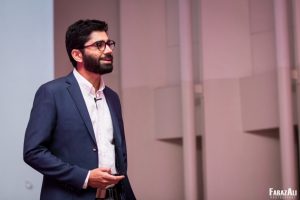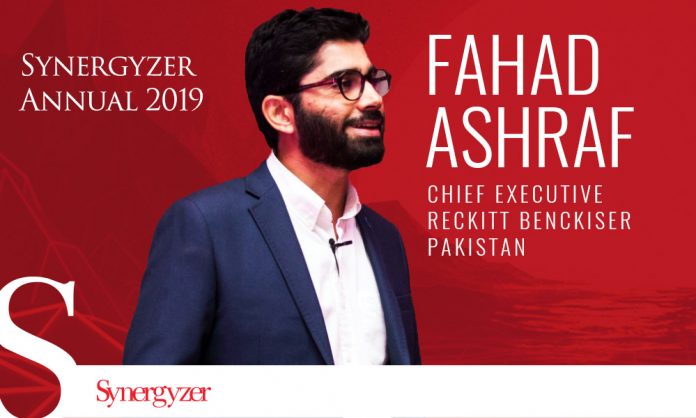As originally published in Synergyzer Annual 2019

Fahad Ashraf, Chief Executive – Reckitt Benckiser Pakistan talks about how the company chooses its media mix and is utilizing the digital medium intelligently.
Synergyzer: Reckitt Benckiser is one of the leading advertisers in Pakistan. The company uses CPRP to determine which TV channels to advertise on. What are some core reasons for adopting this model, as compared to rate-based direct buying?
Fahad Ashraf: RB has a unique hybrid buying model based on ROI (return on investment) and transparency. There are multiple media KPI’s (key performance indicators) that we track with CPRP (cost per rating point) being one of them. This approach allows us to simplify negotiations, provides a common currency and a yardstick to evaluate the campaigns being executed across a spectrum of channels with varying viewership and content.
Synergyzer: Some TV channels deliver extremely low ratings, but their CPRP becomes very high. Do you include such TV channels in your advertising mix?
Fahad: CPRP is a dimension and not the final decision on budget and channel mix. We have overall media ROI targets and based on those, various channels and genres become part of the campaign mix. Ramzan, premium content and affinity-based regional channels are all part of brand building via TV. Our key focus is to drive reach and minimize spillage amongst the channels we advertise on.
Synergyzer: What challenges do you encounter in the Pakistani market in terms of media planning and buying as well as TV channels?
Fahad: Over the years, the content of TV has not evolved much with dramas and current affairs shows eventually revolving around a basic plot. As a result, there is an interest deficit with the younger audience leading to fragmented viewing. Even the global franchise content did not sustain, and no new local content formats were created. Also, the networks did not invest in modernizing content either and the entire responsibility was left with the advertisers to create their own branded content. Thus, there is a vacuum created limiting new viewership for TV, which in the long run will hamper investments coming into the medium.
Synergyzer: How will the audience data audit conducted by PEMRA impact your methodology of using CPRP as the basic unit?
Fahad: Audits bring in accountability. The purpose of such audits is to make the measurability more accurate, which will bring more transparency into our buying. However, it’s important to maintain one ‘version of the truth’ to avoid exploitation and inefficiencies.
Synergyzer: What are RB’s digital priorities in Pakistan?
Fahad: Digital has an edge by its ability to drive engagement. For RB, this provides a way of having ongoing conversations with our audience while understanding and adapting to consumer needs. Moving forward, the priority for RB in 2019 is to nurture and support the ecommerce ecosystem and drive performance marketing, which will provide us pillars for ownable assets to future-proof our growth.
Synergyzer: How much influence does digital have on the overall media mix in your selection of various mediums in Pakistan?
Fahad: Currently, as an industry, our challenge in the digital medium is to create the digital first assets which deliver the message for on-the-go consumption of the medium. It is imperative that we strike a balance between ‘lean on’ content for brand building and ‘lean back’ content for preference building for those brands. Good content on digital will organically grow and give better ROI than any paid asset. Strepsils Stereo is one such example where strong content drove brand top of mind rather than the budget.
Synergyzer: Do you expect digital media to deliver your desired results, or do you think the Pakistani market is still a TV dominant market?
Fahad: Each medium will deliver on its intended role. TV will, for the foreseeable future, remain a reach and frequency driver allowing us to get our message across to a larger audience set. Digital will deliver the incremental reach and audience that you cannot otherwise tap into via TV, allowing for micro targeting and affinity building.
Synergyzer: Does social media help you gauge the pulse of RB brands in Pakistan?
Fahad: Yes. As I mentioned earlier, digital’s ability to have ongoing conversation allows for a real time understanding of consumer trends. With consumers being busier than ever, keeping them engaged requires being present where they are and not where we want them to be. Digital allows us to own such spaces and be a part of the daily lifestyle of consumers via influencer marketing and content embedment. Also digital is the best gauge to changing consumer trends and provides an insight into audience mindset. Views, likes, shares and comments help us get a good insight into their preferences and tastes.
Synergyzer: What else do you do to keep the consumer engaged with the brand?
Fahad: Embedment and content are the future of branded communications. Integration of Dettol Warriors in 3 Bahadur is one such example where the brand comes into a platform the consumers are already engaged in. Consumers today, who will soon become the largest purchase decision makers, follow a brand that is both responsible and serves a purpose. At RB, we have shifted our focus towards purpose-led marketing to drive brands with a more substantial benefit to the consumer, both globally and locally. For instance, RB’s Hoga Saaf Pakistan initiative has collaborated with Government of Pakistan’s Clean Green Pakistan movement to reassure our commitment of making a healthier and cleaner Pakistan.
Synergyzer: Creativity requires room for experimentation and the major support can come from MNC’s in this regard, allowing local creative talent to grow. Why is the creative work limited to creating adaptations of internationally approved concepts only?
Fahad: Local teams at RB are an integral part of the ideation process and development of communications. This involves finding relevant insights into Pakistani consumers, developing storylines that are culturally fit for the local market and including talent that can resonate with the audience. At the same time production quality, investment levels and value for money becomes efficient by having collaborative efforts in developing communications. This allows us to be able to invest further in digital assets that are completely customized local platforms.
For example, Veet Academy is a platform that has provided talented females in Pakistan an opportunity to come forward and groom their personalities enabling them to achieve their dreams. Similarly, last year with the launch of Strepsils Stereo, we introduced the concept of accapella music for the first time in Pakistan, creating content for the market that is proudly Pakistani.

